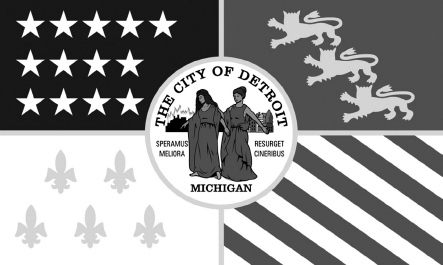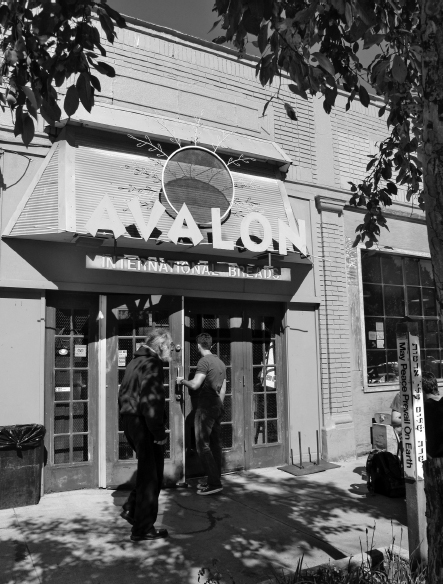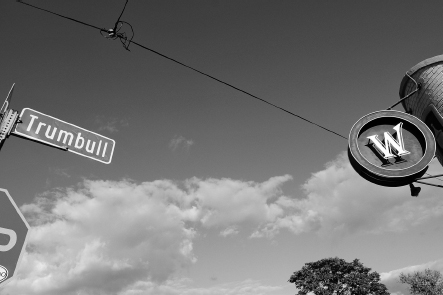
Detroit’s Food Roots
Up from the Ashes
Speramus meliora; resurget cineribus
(“We hope for better things; it will rise from the ashes”).
A group of Detroit history lovers meets once a month in different Detroit bars to hear lectures and discussions on Detroit’s history. With glasses raised high, they repeat Detroit’s motto to start each meeting: one side of the room begins with half the motto, and then the other side responds with the second part: “We hope for better things…it will rise from the ashes.”
Those words are the Detroit city motto, composed in Latin by Father Gabriel Richard right after the great fire of 1805 that leveled the city, which at the time was a village of fewer than two thousand people. Detroit’s motto has an eerie relevance that is so spot on it sometimes makes people gasp when they first read it; how does a city motto written more than 220 years ago speak so directly to what Detroit is dealing with today?
After any terrible disaster in which homes are burned down, destroyed, and family and friends possibly hurt or killed, the first things that put life onto the road to normalcy and the victims to begin thinking of “better things” are shelter and sharing something to eat, especially hot food. If one can eat, one can begin the heavy task of hauling off the charred, smoky wreckage and clearing space for rebuilding the future. Food heals. When one is offered good food that is locally made with knowledge and care, it brings back a love of life and a desire for “better things.” Before you can raise up your city from destruction, you have to have the desire to do it and not just walk away—to see a future that you hope can be better and not just the burned-out homes and destroyed lives. This is why Gabriel Richard’s motto is so perfectly written and fitting.

The flag of the City of Detroit, with the city motto.
The fire of 1805 occurred in June. All suffered. In 1804, Father Richard had built a new children’s school, which was destroyed in the fire. In 1805, there was little medicine other than brandy; it was food people used to nourish the ailing: brandy with hot food, probably soup, poisson blanc (roast white fish so abundant in the Detroit River that it was many times free to be had) or other freshwater fish found in the Detroit River or Lake St. Clair, such as perch, walleye, sturgeon, lake trout or herring. It very well may have been sagamite, a common porridge of cornmeal and maple syrup shared by local Indian tribes. Wild game was everywhere and eaten daily, such as passenger pigeon, offered in a meat pie called la tourtiere. Roast turkey and wild ducks were common fare; the Detroit River continues to be a flyover for millions of migrating ducks, geese and other birds. Even the taste of beaver tail was highly prized. Maybe there was warm bread (Detroit’s horrific fire was said to have been started by a careless baker at the village bakery).
Ironically, today, nearly two hundred years after Detroit’s great fire, it has been a local bakery that has been key to rebuilding one neighborhood. In another part of the city, building a simple corner pub with good food doesn’t seem like much, but it is also transforming an entire historic neighborhood one street at a time.
AVALON BAKERY
“Eat Well. Do Good.”
For many years, the area of the city called Midtown was known as the Cass Corridor. Cass Avenue, which runs parallel to the main thoroughfare Woodward, was then a gritty, narrow street of burned-out buildings, vacant lots, prostitutes and heavy drug and gun violence. It was considered one of the most dangerous streets in Detroit, thereby qualifying as one of the worst streets in the country—not really a place to start an artisan bakery offering 100 percent organic flour, but that’s what happened in June 1997 when Avalon International Breads opened for business.
For Avalon founders Jackie Victor and Ann Perrault, there seems to be no clear line between religion and baking bread. These two women, who were in their thirties when they began, saw something better on Cass Avenue. As they state on their website, “We saw the seeds of a transformation, with food growing on vacant land, small businesses filling unmet needs, artists thriving, and neighbors coming together to rebuild, renew and re-spirit the city from the ground up. And we loved the cultural heritage, legendary architecture, and beautiful international riverfront of our city. Most of all, we loved the incredible souls of Detroiters.”
They raised $6,000 from friends and family who purchased vouchers for bread loaves. With support from family and benefactors, they converted a former art gallery with neither lighting nor plumbing into a full bakery, with a retail facility. Like other startups, they worked beside friends, family and volunteers on eighteen-hour shifts. Today, more than one thousand customers are served at Avalon daily from sunrise to sunset, seven days per week. Three trucks leave each morning, delivering to more than forty restaurants and markets in the region. At every turn, Avalon uses locally sourced ingredients—“local” meaning from local urban farms merely blocks away.
Avalon’s mission has been clear and unwavering: “Eat Well. Do Good.” Mission is sometimes all you’ve got in a neighborhood like the Cass Corridor, but the act of making bread and great baked goods every day is reality. Customers entering Avalon leave the streets of Detroit and find handwritten chalk boards, the smell of baked bread and cookies, the neatness of breads and baked goods displayed on racks and employees who seem dedicated to their love of this place. Voices, bake pans and noise—a constant radio, brimming with life.

Entrance for the Avalon Bakery.
It is so crowded on some mornings that it is not only impossible to find a place to eat, but it’s also almost impossible to move. Still, it has become one of Detroit’s favorite bakeries. Avalon is a bustling place to be for professionals, city cops, college students and locals taking it all in. The glass counter showcases the array of organic rolls, pastries, cookies and loaves one can choose from; racks behind display rows and rows of bread. The bakery offers creative deli sandwiches and desserts to satisfy the sweet tooth. There are seats outside, and except for busy mornings, generally seating is not an issue.
When you visit Avalon International Breads, you must try an absolutely fresh cookie. Bread flavors include a very popular Greektown olive and scallion dill bread and chocolate-filled bread, supposedly good for hangovers. Seasonal favorites include orange cranberry bread and a holiday stollen that alone justifies a trip to Detroit.
WOODBRIDGE PUB
The neighborhood of Woodbridge in Detroit is small but beautiful. It is one of Detroit’s oldest, with many Victorian homes of red brick built in the 1870s. The neighborhood is named for William Woodbridge, governor of Michigan in 1840–41, who owned a large farm on which much of the neighborhood was subsequently built. After his death in the mid-1800s, the land was divided into parcels. This is when the largest and most opulent housing was built, mostly on Trumbull Avenue, as well as on the corners of almost every block. By the turn of the century, many middle-income and working-class Detroiters had filled in the land with more moderate single-family and two-family homes. By the Depression of the 1930s, the inhabitants had changed to lower-income residents, and many landlords had divided two-family homes into tenements and rooming houses. Poverty then set in. And so goes an all-too-depressing pattern in Detroit’s neighborhoods.
Jim Geary came to the neighborhood in 2001. He was born and raised on a farm in Salem, Michigan, and had no experiences in large cities. He claimed to have grown up on a family farm amid “lots of old stuff.” He moved to Ann Arbor and worked for a coffee roaster with a chain of shops, setting up new shops and taking them down as they were regularly opening and closing. However, something was lacking in Ann Arbor—a certain attitude to which he couldn’t relate. When he came to Detroit, and more specifically Woodbridge, there was an immediate connection. “I felt like I was home,” he said.
In December 2006, he bought the building at a forgotten corner at Trumbull and Merrick Streets, which at the time was an abandoned general store of sorts. It had been empty for twenty-five years. He began rehabilitating it with a plan for a restaurant. One feature that he was set on was large windows. He wanted light in the restaurant, and he wanted people to be able to see into the restaurant. This was a risk; crime was still high in the area, but he insisted that he did not want the feeling that crime was a determining issue or that the restaurant was a war bunker.

The Woodbridge Pub.
He brought in materials from other lost causes: the long oak bar of the Woodbridge Pub is from a church rail in Saginaw. An old wood-paneled walk-in cooler salvaged from a closed butcher in Hamtramck serves as a very soundproof restroom. Other features include the original flooring and a stamped tin ceiling.
Although he had absolutely no experience in the restaurant business, it became a cause for Jim, and he threw himself into the work. “I did a lot of market research,” he said. While not a chef, he approves the menu, which is filled with extraordinary salads and a steak sandwich that is extremely tender and close to a beef filet. Like other restaurants in the city, he offers healthy options, such as black bean and white bean burgers. Some of his personal favorites include the Maui Maui burger. The restaurant does Sunday brunches, which are packed, and he has added Sunday night pizzas, also very popular. Prices are low for food, and there is a respectable list of regional and craft beers, again on Jim’s insistence.
Patrons come from everywhere: Wayne State University students and staff, after-hours theater patrons, hospital personnel and even suburbanites. Many of the latter say to him, “If we could only move this place to our town.” Jim knows that this could never happen—it is the spirit of Woodbridge Pub and the neighborhood that drives him and his staff, which he calls his real “family.”
Early on in the pub project, Jim realized the importance of the neighborhood to its success. As he said, “You cannot operate a business in a crime-ridden, litter-strewn setting.”
The city offered nothing, so he took it on himself. “Who’s gonna do this?” he asked himself. “I learned that the best help I could offer Detroit was to take care of my little corner myself. I take care of my street.” He began by keeping the sidewalk at the pub cleaned from litter. He mowed the vacant lot across the street, eventually buying it to keep it cleaned; soon, others in the neighborhood turned it into a community garden. Jim shovels the snow not just at the restaurant but throughout the neighborhood as well. His restaurant staff members, who know Jim’s commitment, go down the streets trimming trees of overhanging branches. “We take pride where we live.”
It is not gentrification, he added. “The recession in the mid-2000s was actually a good thing. The neighborhood has a long history of diversification, economic and racial. While once an elite area—the home of Ty Cobb, George Booth and others—it fell into neglect during the depression, and many homes were subdivided for workers, later for Wayne State University students. The recession of 2000 slowed down the money that drives up home prices and drives many people out of the area…This didn’t happen.”
While the restaurant is a success, Jim continues to rehab houses. Bringing to life this neighborhood is a personal mission. It drives him. The crime problem has improved, but the fear of crime is a suburban mindset, Jim claimed. While there is crime, he and others don’t think of it continually. “You know, there are neighborhoods that are crime-ridden, but that doesn’t mean all neighborhoods are crime-ridden. If something happens to people in the suburbs, they ask, ‘Why did this happen to me?’ whereas, people living in the city typically think, ‘Why was I so dumb to allow this to happen?’”
Jim sees no need to expand, but he would like to see other stores open on Trumbull. With his drive, they will.